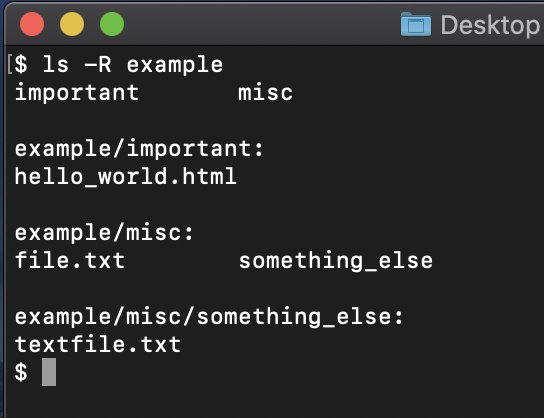

- #MAC COMMAND LINE LIST CONTENTS OF DIRECTORY INSTALL#
- #MAC COMMAND LINE LIST CONTENTS OF DIRECTORY WINDOWS#
To see them in the terminal, you use the "ls" command, which is used to list files and directories. In the Finder window, we see the contents of the "/Users/ModulesUnraveled" directory. Listing files and folders in the current directory This will make it easier to follow along throughout the series. I'll also split the screen so that the terminal is on the left and the Finder window is on the right. Let's go to this directory in Finder to follow along. If I type it and press Enter, the result is "/Users/ModulesUnraveled". There may come a time when you don't know which directory you are currenly in.
#MAC COMMAND LINE LIST CONTENTS OF DIRECTORY WINDOWS#
Windows will commonly use ">".) Seeing which directory you're currently in (Some systems use a symbol other than the "$" including "%" or "#". Finally we'll see "ModulesUnraveled" which is my user name, and a "$" which is the prompt that indicates it is ready for me to type my command. You'll see "Brians-MacBook-Air" which is my computer name, followed by a colon and then a "~" (which indicates the user home directory) and that is the directory I am currently in. Once it's opened you'll see the last login time on the first line, while the second line shows information about my computer, what folder I'm in and who I'm logged in as. The first thing we need to do is open up our terminal. See Set variables in a pipeline for instructions on setting a variable in your pipeline.In this video we'll use the "pwd" command to see what directory we are in, and the "ls" command to list the files that are in our current directory. See Node.js documentation for more details about this variable. You can either add the NODE_EXTRA_CA_CERTS=file environment variable to your build agent, or you can add the .CERTS=file task variable in your pipeline. This can be fixed by adding a trusted root certificate.

My NuGet push task is failing with the following error: "Error: unable to get local issuer certificate". I can't select a default agent pool and I can't queue my build or release. You need at least one agent to run your build or release. FAQ Where can I learn Windows commands?Īn A-Z Index of the Windows CMD command line Do I need an agent?

Advanced, Working folder: $(Agent.BuildDirectory).:::image type="icon" source="media/command-line.png" border="false":::ĭisplay all files in all the folders created by the build pipeline. On the Build tab of a build pipeline, add these tasks: WorkingDirectory: $(Agent.BuildDirectory)ĭisplayName: Set a variable and then display all If you have a secret variable called Foo, you can map it in as shown in the following example. (Optional) A list of additional items to map into the process's environment.įor example, secret variables are not automatically mapped. If this is true, this task will fail if any errors are written to stderr If you leave it empty, the working directory is $(Build.SourcesDirectory). (Optional) Specify the working directory in which you want to run the command. (Required) Contents of the script you want to runĭefault value: echo Write your commands here\n\necho Hello world\n"
#MAC COMMAND LINE LIST CONTENTS OF DIRECTORY INSTALL#
You may not realize you're running a batch file.įor example, npm on Windows, along with any tools that you install using npm install -g, are actually batch files.Īlways use call npm to run NPM commands in a Command Line task on Windows. You should always prepend call before executing a batch file in an Azure Pipelines script step. This will result in Azure Pipelines running your intended script up until the first batch file, then running the batch file, then ending the step.Īdditional lines in the first script wouldn't be run. When you want to run a batch file from another batch file in Windows CMD, you must use the call command, otherwise the first batch file is terminated. The CmdLine task also has a shortcut syntax in YAML: - script: # script path or inlineĮnv: # mapping of environment variables to addĪzure Pipelines puts your inline script contents into a temporary batch file (.cmd) in order to run it. # Run a command line script using Bash on Linux and macOS and cmd.exe on Windows


 0 kommentar(er)
0 kommentar(er)
